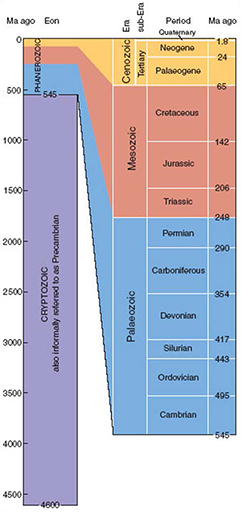1.4.4 Stratigraphy and geological time
Stratigraphy is the study of how the types of strata have varied over time and also considers how they are distributed geographically. One of the most useful results of stratigraphy is a generalised geological succession – the stratigraphic column – that defines the divisions of geological time. Figure 11 shows the geological time-scale. The broadest division of Earth history is into two intervals (called eons) of very different length: the Cryptozoic Eon and the Phanerozoic Eon. The Cryptozoic is a vast amount of time – from the origin of the Earth, 4 600 million years (Ma, short for mega-annum) ago, to the start of the Phanerozoic, 545 Ma ago. Cryptozoic is derived from Greek words meaning ‘hidden life’. This is the period of time when organisms did not possess hard parts such as shells, so their remains are difficult to find in sedimentary rocks. In contrast, Phanerozoic is derived from Greek words meaning ‘visible life’, reflecting the great abundance of fossils derived from the hard parts of organisms throughout this eon. The Phanerozoic Eon is divided into three eras – the Palaeozoic, Mesozoic and Cenozoic Eras (meaning ‘ancient life’, ‘middle life’, and ‘recent life’, respectively). Each of these eras is divided into a number of periods of unequal length (Figure 11). The current period, which started 1.8 Ma ago, is the Quaternary Period.

Looking at this column, you might think that there is a complete sequence of rocks everywhere, but there is not, in the same way that there are no historical records for certain times from certain areas. In the field, the Earth scientist might find rocks of, say, the Triassic Period lying above and in direct contact with rocks of the Carboniferous Period, so that rock evidence for the Permian Period is not present. This means that either there was no deposition of sediment during the Permian Period, or that these rocks were deposited, and then eroded, before rocks of the Triassic Period were laid down. This type of relationship in the geological rock record, where at a contact there are beds of the intervening age missing, is called an unconformity. The recognition of unconformities in the field is a key part of unravelling the geological history of an area because they represent some sort of hiatus in the conditions at the Earth's surface where the sediments were deposited.
